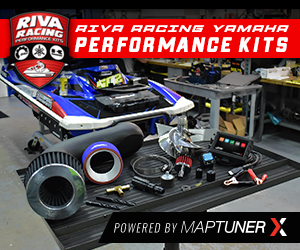[I’ll preface this by apologizing, as I know what I’m about to say will likely infuriate the most passionate of racing enthusiasts. It’s been a lifetime’s worth of experience to teach me that I have an uncanny talent for enraging people, so again, you’ve been warned. -Ed.]
People say “racing is dead.” I disagree. Racing is not dead, it’s just irrelevant. I say this without intent to discredit the talent, training and dedication of the many passionate racers who faithfully pay their dues both figuratively and literally. I say it as a reflection of its current health. The sad reality is that personal watercraft racing is teetering on its last leg.
But it can be big again and with very little effort. And I believe I know how.

Racing mattered most when it translated into unit sales, and it is no coincidence that racing’s apex paralleled the industry’s all-time height in unit sales. The two are intrinsically tied. As an illustration, consider this cyclical chain of cause and effect:
Step 1) Imagine there is a new found consumer interest in personal watercraft – for whatever reason. The new broad consumer appeal immediately translates into a spike in PWC sales. OE’s and dealerships see immediate profitability.
Step 2) A rise in watercraft sales invites more people to modify their skis (because it’s human nature to want to go faster), therefore encouraging the growth of an aftermarket. A vibrant aftermarket rightly influences the next generation of OE product, thereby providing superior vehicles. (We have all seen this happen firsthand, most recently with the SVHO Yamaha and 310-horsepower Kawasaki.)
Step 3) An increase in performance-bred watercraft, dramatically increased gains by the OE’s and aftermarket paired and a new swollen population of PWC enthusiasts consequently results in increased attendance in existing local and regional racing events. This encourages new promoters to provide more and larger events wherein newcomers can compete.
Step 4) With vibrant dealer sales, OE’s begin pouring extra marketing dollars into encouraging new additional sales, as well as creating stronger brand loyalty and awareness. The more successful aftermarket companies do likewise. This results in greater event support, larger venues, bigger racer payouts, and increased public interest and racer participation…which in turn, leads to greater interest in PWC and consequently, sales.

The burning ember that gave life to this chain of events 40 years ago was the introduction of the first JetSki. The newness of the vehicle gave birth to an industry. And following the exact model I outlined above, from 1991 to 1995, jet ski racing saw its highest numbers of events, tours, racers, participants, spectators and sponsorship dollars as sales peaked at 200,000 units sold annually (1995).
But by the late 1990s, the aftereffects of decades of bad behavior, concerns of environmental impact and a general malaise on behalf of the organizing bodies resulted in a steady decline which nearly snuffed out the once out-of-control brush fire that that one initial spark ignited. It was only due to steeled dedication and determination of those wholly dedicated to this industry that PWC racing has held on at all.
But I fear that it can’t last much longer as is. Preliminary sales reports of narrowly surpassing 29,000 units sold and less than 900 paying members of the IJSBA for 2013 convinces me that if something doesn’t change soon, we won’t see the “comeback” we all dream of. And right now, I don’t see anyhing on the horizon that will parallel the same level of catalyst as the initial standup JetSki.
Rather than trying to rekindle the same flame that ignited the sport over 30 years ago, its best that we artificially arouse the aforementioned cause and effect cycle that’s already in motion, like push-starting an old VW Beetle. Thankfully, we’re already a few steps into my earlier example as the OE’s and aftermarket have never produced better, more race-ready quality products.
What is needed are enough people racing to get the attention of the OE’s. But there’s the rub: purchasing a new runabout is expensive, and racing is only more so. The deterrents are too many, while the rewards are too little. Thereby, racer attendance is low. So, how do you mitigate the cost of racing to encourage more participation? Easy. Manufacturer Stock Classes.
Manufacturer Stock classes aren’t anything new, and have been successfully executed at the Long Beach-to-Catalina Offshore Championship, the legendary Mark Hahn Memorial Havasu 300, and of course, is the standard rule setting for all AquaX race events. By restricting modifications to a near, if not total minimum, enthusiasts are left to battle brand-against-brand, racer-against-racer rather than against each others’ pocketbook.
Frankly put, the OE’s hardly care about the Open and GP classes. Sure, they’re happy when it’s their ski is on the podium, but don’t expect them to greedily pursue it. Heck, even Limited is too far removed from what’s offered on showroom floors. No. The manufacturers will only care about racing when the skis participating are nearly identical to what the regular customer can purchase.

And I feel very strongly that the AquaX series has all of the DNA necessary to reignite this cycle. Its tightly controlled three-tiered class system, tech inspection and commitment to fun and safety is the right formula. As pointedly as possible, the OE’s are stupid not to support the AquaX with as much as their budgets can allow. Consider the following:
Step 1) All local and regional promoters offer Manufacturer Stock classes with reduced entry fees. Lower costs entice new grassroots racers, youth and racers from other classes to participate. Increased entry fees permit larger payouts, encouraging more participants yet.
Step 2) As more and more participants enter Manufacturer Stock classes, the OE’s begin taking notice and supplementing the events with larger payouts. This in turn, lures in more racers (new and old) to the class. More racers wanting to participate purchase new units.
Step 3) An increase in sales directly tied to additional Manufacturer Stock entries encourages vigorous OE and dealer support, thereby provoking promoters to host more events and open up larger venues. This draws in broader public appeal, welcoming new watercraft owners and rekindling interest with previous PWC owners.
Step 4) More public appeal converts into an increase in unit sales. OE’s and dealerships see immediate profitability.
And away we go again…
Go Get Wet,
Kevin
All images courtesy P1 AquaX USA
Addendum: It has come to my attention that for 2014, the US series of the AquaX has completely recanted from its “Box Stock” policy and has caved to pressures from individuals (and most likely manufacturers as well) to better “level the playing field.” Of course, as we all know, the only people who cry for the playing field to be leveled, want the rules changed in their favor. So, I guess I must retract my outright support for AquaX and remain solidly behind RPM Enterprise’s Ross Wallach’s Manufacturer Stock class rules. Manufacturer Stock should remain stock. What a shame.









